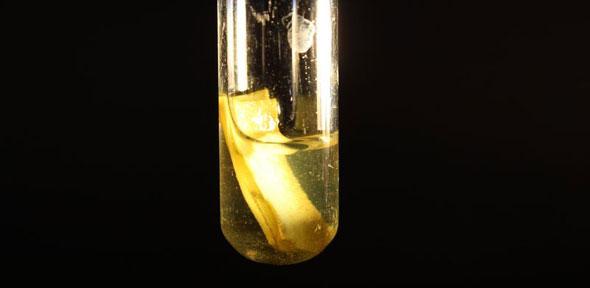Two groups of students, AeroDelft in The Netherlands and ETH Cellsius in Switzerland, are making great progress on some extremely advanced aeronautical projects. Each school’s ultimate goal seems to be flying with liquid hydrogen, and each has a slightly different approach to that goal. AeroDelft: Starting Small AeroDelft, the student-led project at Delft University of Technology, flew a 1/3 scale model that closely resembles e-Genius in July. Its 1,500 Watt (two kilowatt) motor is powered by 40 grams (1.411 ounces) of gaseous hydrogen initially, but will transition to liquid H2 later in the program. 380 grams (13.4 ounces) of the more potent fuel will allow three hours endurance and a range of almost 300 kilometers (186 miles) Since that flight, the team has exhibited at various trade shows and advanced work on its Sling 4 two-seat light aircraft. The 920 kilogram (2,024 pound) maximum takeoff weight aircraft, powered by a 110 kilowatt (147.4 horsepower) motor flies on battery power for …
Efficient and Cheap Catalyst for Water Splitting
University of Houston physicists think they may have overcome the last hurdle to generating abundant hydrogen, a fuel that is as elusive as it is clean. Their new catalyst, “composed of easily available, low-cost materials and operating far more efficiently than previous catalysts,” could solve at least one of the problems associated with generating and storing H2. Jeannie Kever, writing for the University newsletter, reports Paul C. W. Chu, TLL Temple Chair of Science and founding director and chief scientist of the Texas Center for Superconductivity at UH and colleagues physicists Zhifeng Ren and Shuo Chen, have created a catalyst “Cost-wise… much lower and performance-wise, much better.” The quote comes from said Zhifeng Ren, M.D. Anderson professor of physics and lead author on the paper. The catalyst has operated more than 20 hours and 10,000 cycles in testing. Other researchers involved in the project include postdoctoral researchers Haiqing Zhou and Fang Yu, and graduate students Jingying Sun and Ran He. Their …
Making Hydrogen at Ambient Temperature with Biomass
Hydrogen would be a nearly perfect fuel if it didn’t take more energy to extract it than you can get out of it. Scientists have been working for years to isolate it in an economical fashion. The most common element in the universe, hydrogen makes up 10 percent of the weight of living things here on earth – mainly in water, proteins and fats. Its bonds in water make it pervasive, but still distant. Obtaining it can be as simple as the video below. But the short bursts derived from this approach will exhaust the battery and not provide as much energy in return. Waste Not, Want Not Ironically, much of the earth’s other resources, more easily gained, are wasted in our society’s rush to consume. Recent reports show that up to a third of the food produced today goes to waste. Huge quantities of biomass could seemingly be put to good use rather than adding to the methane that …
Hydrogen as a Biofuel?
While we’ve written recently about “artificial leaves” that emulate the photosynthesis of their real counterparts, researchers have announced the discovery of a way to extract hydrogen from any plant, which “could help end our dependence on fossil fuels,” according to Y. H. Percival Zhang, associate professor of biological systems engineering in the College of Agriculture and Life Sciences and the College of Engineering at Virginia Polytechnic Institute and State University (Virginia Tech). The school describes the process as a “breakthrough that has the potential to bring a low-cost, environmentally friendly fuel source to the world.” Zhang has been working on the problem for over seven years, and like many pioneers, has endured the critical appraisal of those not in tune with his aspirations. Esquire magazine in its November 2006 issue labeled Zhang’s early iteration of his idea to break down plant sugars to create cheap cellulosic ethanol and possibly even hydrogen as the “Crazy idea of the year: “sugar cars.” …
New “Leaf” Turns Over More Energy
Scientists have been working on imitating nature’s ability to photosynthesize the sun’s energy, much as plants turn that energy into food for their health and growth. Daniel Nocera, for instance, created an artificial leaf that split water into oxygen and hydrogen that could fire up a small fuel cell and run an electric light. According to a Science Pub lecture your editor recently attended, an eight-ounce glass of water can power a 60-Watt bulb for 20 hours. Nocera, in a Pop! Tech talk, claims an Olympic-size swimming pool could supply all the world’s energy needs. Nocera now works at Harvard, but researchers at Massachusetts Institute of Technology (MIT), his former home, are taking his work further, detailing all the limitations that keep his “artificial leaf” from giving off more storable energy. As explained in the MIT press release, “The original demonstration leaf, in 2011, had low efficiencies, converting less than 4.7 percent of sunlight into fuel… But the team’s new …
$1.50 a Gallon, Carbon-Free, and Maybe?
Gizmag readers responded pretty much equally with hope and skepticism to today’s story on Cella Energy’s announcement of their hydrogen-based, emissions-free fuel that would power your car for $1.50 a gallon. One asked if it were April 1 yet. Others held out more charitable views of the announcement, and perhaps deservedly so. Cella’s diagram compares bulky high-pressure storage with room-temperature, ambient-pressure storage solution Cella is partially a spinoff of Oxford University’s ISIS programs, named for the Egyptian goddess of magic and life and overflowing with demonstrated successes. We’ve reported on their Yokeless And Segmented Armature (YASA™) topology motor, a 34-centimeter (13.4 inches) diameter, 7-centimeter (2.76 inches) thick, 11 kilogram (23.2 pound) marvel that can produce a peak 100 kilowatts and 700 Nm (516 foot-pounds) of peak torque. Cella’s web site claims several important factors that would lead to success, including: “Hydrogen fuels for vehicle you can pump like regular gasoline at room temperature and pressure, safer to use than gasoline or …
Eco-Marathon an Echo of the Green Flight Challenge
Think of the Green Flight Challenge flown on a much smaller course, but allowing hydrogen fuel cell powered balloons to compete against liquified natural gas powered ultralight aircraft, or solar-powered autogyros. You might get a small idea of the creativity and innovation that sponsors hope to unleash in an upcoming event. In the town of Vichy, France, at the Vichy-Charmiel airfield, on July 9-11, the Eco Marathon ULM (Ultra Light Machines) will be held to test the limits of how little energy can be used to fly an aerial craft around a closed-circuit course three times. The rules are simple. The craft using the least energy wins – like the CAFE Foundation’s 2011 Green Flight Challenge, and inspired by the Shell Marathons for high school students who build extreme vehicles that get extreme mileage. There are no speed or weight requirements outside those imposed by the French Civil Aircraft Authority (the DGAC) on the various types of aircraft. Since participants …
Man of La Manche
The French call the English Channel “la Manche” (the sleeve), nicely describing the shape of the waterway while neatly avoiding calling it “English.” Gerard Thevenot, a long-time championship-level hang-glider pilot, celebrated the centennial of Louis Bleriot’s flight across la Manche by flying his hydrogen-powered La Mouette hang glider over roughly the same route Bleriot took between Calais and Dover on August 6, 2009. Missing the centenary by a few days (Bleriot made the hop on July 25, 1909), Thevenot took an hour and seven minutes to duplicate the trip Bleriot managed in 37 minutes. Having displayed his craft at Aero Expo 2009 at Friedrichshafen, Germany in April, Thevenot also participated in the Coupe-Icare, an aeronautical-artistic fantasia near Grenoble, France before making his historic flight. Like Bleriot, he essentially created his own machine, crafting a simple trike frame to attach to his wing, and adding two hydrogen cylinders, three 2 kW fuel cells, and the controller, motor and propeller developed by Drs. Eck and Geiger. …



